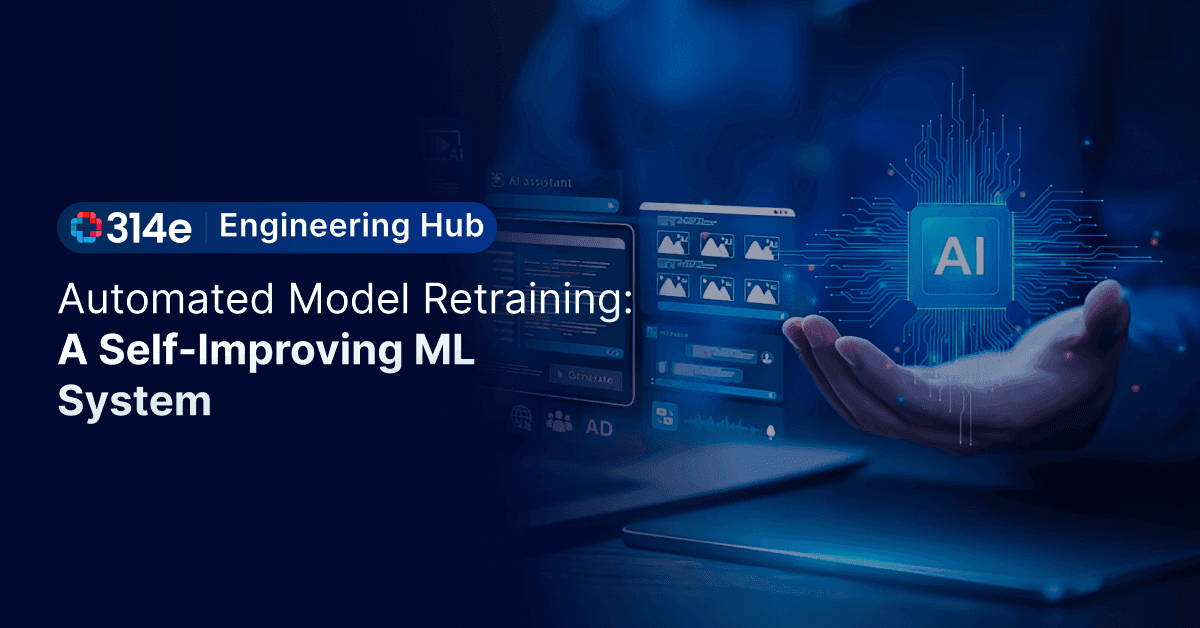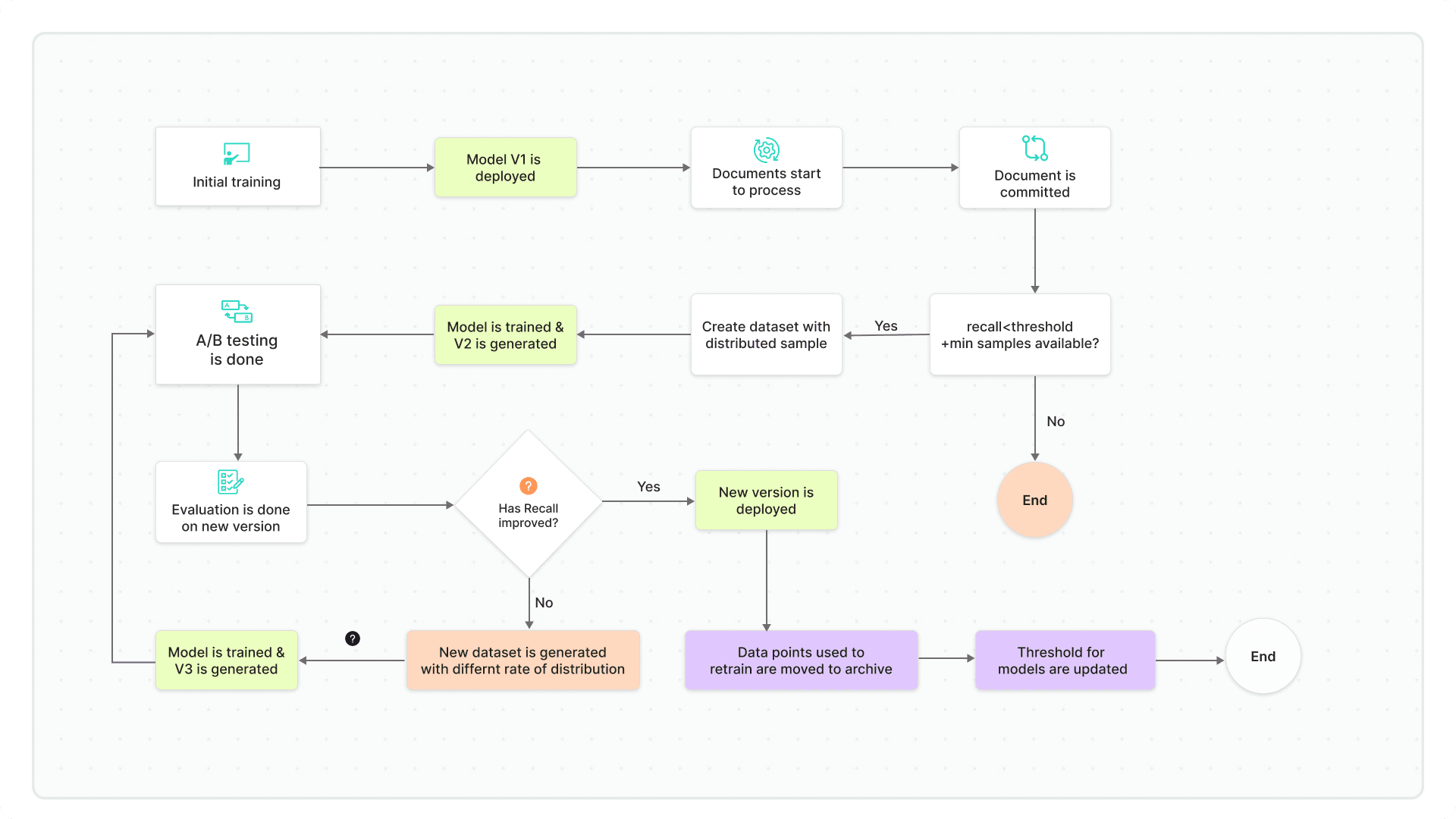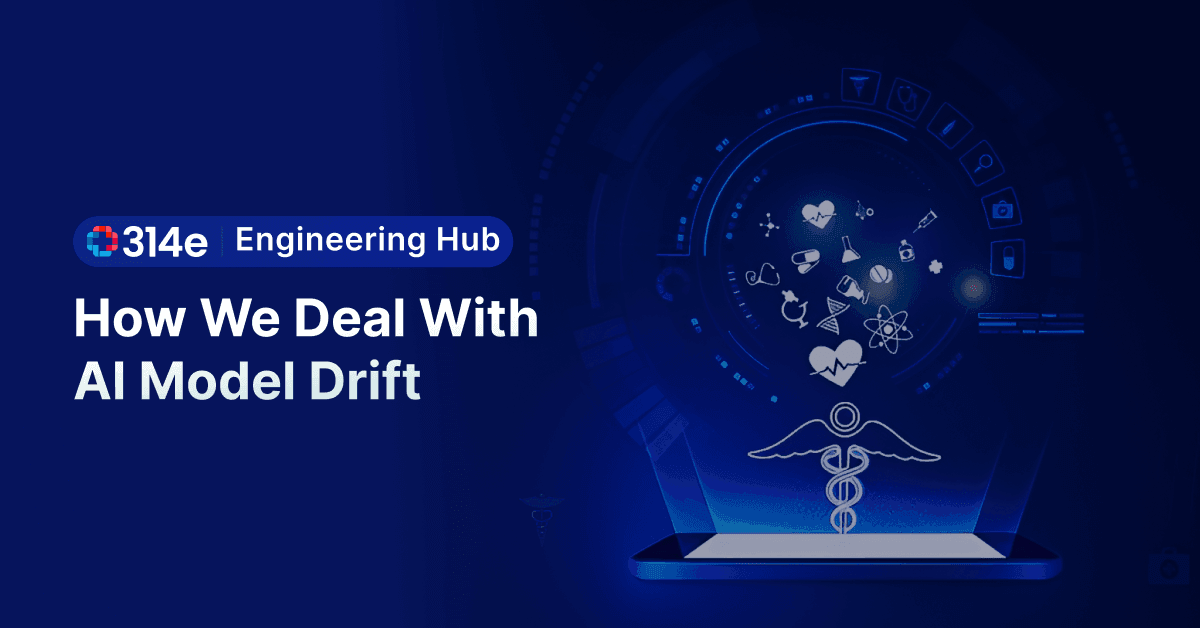
Automated Document Processing With Dexit: Behind the Scenes of AI Document Extraction & Classification
Dexit stands out with its ability to classify documents, extract key entities, and enable seamless …

So, you've deployed your shiny new ML model. It's acing predictions, and life is good. But how do you ensure it stays that way—or gets even better? Often, we wait for the familiar trouble of model drift before a manual model retraining slog begins. But what if you could proactively refine your model based on expert feedback, even before performance visibly sags?
In this post, we're not just talking theory; we’re pulling back the curtain to show you exactly how we built a system at Dexit—314e’s Intelligent Document Processing Platform that does both.
Get ready to dive into a self-improving architecture powered by automated model retraining, and learn how to make your models continuously learn and adapt.
What this blog talks about:
Simply put, model drift is when the world your model lives in changes, but your model doesn't. The data it sees in production starts to look different from the pristine dataset it was trained on.
This usually shows up in two main flavors:
The bottom line? Your model’s understanding gets stale, and performance tanks.
(If you want the full-blown deep dive on all things model drift, check out our previous post: Why is my AI Model's Performance Degrading? How to Solve Model Drift – we really get into the weeds there.)
The model drifts, and the traditional response? Manual intervention for retraining the model.
While this approach might seem direct, it presents several significant operational challenges, particularly as AI systems scale:
This reactive cycle underscores the necessity of shifting towards a continuous training machine learning paradigm. We require systems designed for ongoing adaptation and learning, rather than periodic, labor-intensive interventions. This is where the value of automated model retraining, as implemented in Dexit's architecture, becomes evident. Let's delve into how such a system is structured.
To illustrate a practical approach to automated model retraining, we'll walk through the MLOps architecture implemented within the Dexit platform.
Dexit processes a diverse range of documents, relying on sophisticated models for understanding and extracting information. The primary models involved in this continuous improvement loop are:
This multi-model environment underscores the need for a robust and adaptable retraining pipeline. Let's explore the core steps that constitute Dexit's self-improving system.
Here's Dexit’s core automated model retraining system at a glance.

The journey to deploy Model V1 begins with data acquisition from the client. After manual EDA and preprocessing of raw documents (including PDF to JPG, OCR, and bounding box generation), the processed data is formatted and stored (e.g., in an R2 bucket). Model V1 is trained using Python scripts, with all training parameters, metrics, and code versions meticulously logged to an open-source MLOps platform for reproducibility. Following training, Model V1 is rigorously evaluated on a held-out test set, with these critical metrics also logged. Upon successful evaluation, Model V1 is registered in a Model Registry. Finally, the validated Model V1 is deployed for inference via Dexit's API, its status tracked in database tables where it's marked as the default, ready for continuous monitoring.
Once a model version is live, the system actively learns from user interactions. This feedback is pivotal for its adaptation and improvement, akin to reinforcement learning from human feedback.
With ongoing feedback, the system continuously monitors the performance of the active Model V1.
When retraining is triggered for the current Model V1, a new, targeted training dataset is constructed to produce Model V2.
With the curated dataset ready, the actual retraining process begins.
Before deploying Model V2, it undergoes rigorous evaluation against the incumbent Model V1.
If candidate Model V2 proves superior to Model V1:
Not every retraining attempt guarantees improvement. Dexit's "Alternate Path" handles scenarios where the candidate Model V2 fails evaluation against Model V1:
Building and maintaining an automated model retraining system like Dexit's is an iterative journey, filled with valuable lessons. Whether you're just starting or looking to refine an existing MLOps pipeline, consider these key learnings and best practices:
The entire premise of a self-improving system driven by user feedback hinges on the quality of that feedback. While it's tempting to gather as much data as possible, noisy, inconsistent, or ambiguous corrections can lead your model retraining efforts astray, potentially even degrading performance.
Best Practice: Implement mechanisms to validate or review feedback, especially if it comes from diverse user groups. Ensure your UI/UX for feedback capture is clear and minimizes opportunities for erroneous input. The effectiveness of your reinforcement learning from the human feedback loop directly correlates with the signal quality.
Simply throwing all accumulated feedback into your next training run is rarely the optimal strategy. How you select and sample data for machine learning model retraining drastically impacts outcomes.
Best Practice: As seen with Dexit's approach, employ targeted sampling. For classification, balance corrected samples with non-corrected ones to prevent catastrophic forgetting. For entity extraction, stratify samples based on current performance (e.g., oversample errors for low-performing entities). There's no one-size-fits-all; experiment and tailor your sampling to your specific models and data characteristics.
Before promoting a newly retrained model version (e.g., V[1+1]) to production, you must have an unambiguous definition of what constitutes an "improvement" over the current version (V1).
Best Practice: Establish explicit, quantifiable criteria. This involves selecting key performance metrics (overall accuracy, F1-scores for critical classes/entities, recall for high-impact errors) and setting thresholds for improvement. Also, define acceptable regression tolerances for other metrics. Ensure these are evaluated on consistent, held-out test sets.
An automated retraining pipeline is itself a complex software system. While it's designed to monitor your ML models, the pipeline itself requires oversight. Failures in data ingestion, workflow execution (e.g., Temporal jobs), or infrastructure provisioning (e.g., an open-source framework for running AI workloads) can silently break your continuous learning loop.
Best Practice: Implement robust logging, alerting, and monitoring for all components of your MLOps infrastructure. Track pipeline health, job success rates, and resource utilization.
Your first automated model retraining system will likely not be your last or perfect version. The data landscape evolves, business requirements change and new modeling techniques emerge.
Best Practice: Treat your MLOps pipeline as a living system. Regularly review its performance, analyze retraining outcomes, and be prepared to refine your strategies—be it sampling logic, evaluation criteria, or even the underlying tools. Continuous improvement applies to the pipeline itself.
Continuous training in machine learning, while beneficial, has resource implications. Frequent retraining, especially of large models, consumes compute resources (CPUs, GPUs, memory) and incurs costs.
Best Practice: Optimize your training jobs for efficiency. Explore techniques like early stopping or efficient fine-tuning. Implement smart scheduling for retraining (e.g., trigger only on significant drift, or during off-peak hours where feasible). Balance the desire for constant model freshness with pragmatic resource constraints.
Dexit's journey underscores a vital MLOps truth: static models can't keep pace. Automated model retraining offers a powerful solution, delivering proactive model drift management, sustained accuracy, and efficient use of engineering talent. While Dexit's specifics are unique, the core principles—robust feedback loops (leveraging reinforcement learning from human feedback), diligent monitoring, automated triggers, and strategic dataset creation—are universal for effective continuous training in machine learning. Embracing automated machine learning model retraining is no longer a luxury but a necessity for building resilient, adaptive AI. The future is self-improving; let's architect it.
CONTRIBUTORS BEHIND THE BUILD
Join over 3,200 subscribers and keep up-to-date with the latest innovations & best practices in Healthcare IT.

Dexit stands out with its ability to classify documents, extract key entities, and enable seamless …

AI models, especially Large Language Models (LLMs), don’t degrade like perishable goods. But over time, you’ll …

Healthcare data is as vast as it is complex, encompassing millions of medical records, clinical notes, …